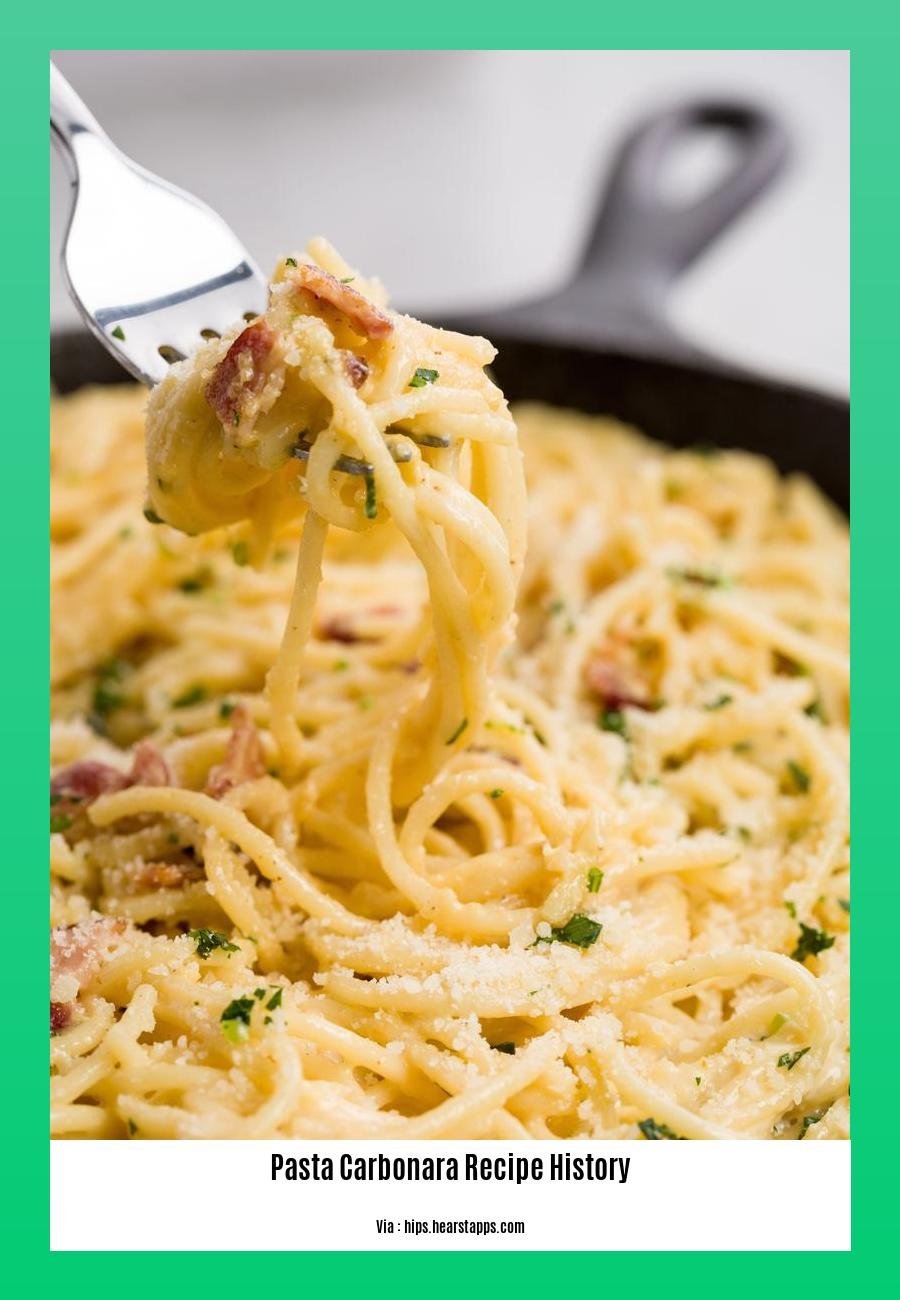Embark on a culinary adventure as we delve into the tantalizing history of Pasta Carbonara, the irresistible Italian classic. From its humble origins to its global acclaim, we’ll uncover the secrets behind this beloved dish and provide you with an authentic recipe to recreate its timeless flavors in your own kitchen—[The History Behind the Irresistible Italian Classic: Pasta Carbonara Recipe].
Key Takeaways:
- Pasta Carbonara originated in Rome and the Lazio region.
- It is a classic dish composed of spaghetti, guanciale (or bacon), pecorino Romano cheese (or Parmesan), eggs, and black pepper.
- The preparation involves cooking the pasta without butter, cream, or garlic.
- Eggs and cheese are beaten together, while the guanciale is sautéed.
- The eggs are tempered with hot pasta water before being tossed with the pasta and seasoned with pepper.
Pasta Carbonara Recipe History

Carbonara, a timeless Italian dish, holds a captivating history woven into its delectable flavors. This beloved pasta, with its origins intertwined with Rome and the Lazio region, has evolved from humble beginnings to become a culinary icon.
Origins: A Medley of Flavors
Pasta carbonara traces its roots to a family of dishes that featured pasta, bacon, cheese, and pepper. Its name, derived from “carbonaro” (charcoal burner), hints at its possible origins among charcoal workers who needed a hearty and portable meal.
Ingredients: A Symphony of Simplicity
The essence of carbonara lies in its carefully chosen ingredients:
- Spaghetti: The traditional pasta, providing a sturdy base for the rich sauce.
- Guanciale: Cured pork cheek, adding a smoky, savory depth. (Pancetta or bacon can be used as substitutes.)
- Pecorino Romano: A salty, nutty cheese that complements the guanciale’s flavor. (Parmesan cheese is a common variation.)
- Eggs: Yolks and whole eggs create a luscious, creamy sauce.
- Freshly Ground Black Pepper: A finishing touch that enhances the dish’s aromatic complexity.
Preparation: A Culinary Dance
Creating carbonara requires precision and a harmonious blending of ingredients:
- Pasta Mastery: Cook the spaghetti without butter or cream, preserving its purity.
- Egg Symphony: Whisk the eggs and cheese in a bowl, creating a velvety base.
- Guanciale Delight: Sauté the guanciale until crispy, releasing its smoky essence.
- Tempering Touch: Temper the eggs by slowly adding hot pasta water, preventing curdling.
- Pasta Embrace: Toss the pasta with the egg mixture, allowing it to absorb the rich flavors.
- Pepper Perfection: Season with freshly ground black pepper, balancing the savoriness with a spicy kick.
Carbonara’s simplicity belies its exquisite taste, a testament to the culinary artistry that has made it a beloved dish across generations. Embark on a journey into its flavorful history and savor the timeless legacy of pasta carbonara.
Did you know that the history of pasta carbonara traces back to the 1940s? Or that the origin of carbonara is still debated today? If you’re interested in the history of italian cuisine, and want to learn more about its evolution, make sure to check these links.
Regional Variations: Exploring Diverse Interpretations
Carbonara, a testament to Italian culinary artistry, transcends regional boundaries, inspiring countless variations that showcase the diverse tapestry of flavors across the country. From the Lazio countryside to the bustling streets of Rome, each interpretation adds a unique twist to this beloved dish.
Key Takeaways:
- Carbonara is a canvas for regional creativity, boasting variations that span Italy’s diverse culinary landscapes.
- Regional variations encompass different types of pasta, cheeses, meats, and cooking techniques.
- Despite its variations, Carbonara remains a symbol of Italian cuisine, its essence preserved in each unique interpretation.
Most Relevant URL Source:
- Carbonara: Origins and Anecdotes of the Beloved Italian Pasta Dish
The Art of Emulsification: Mastering the Creamy Texture

As I delve into the realm of pasta carbonara, I’ll also explore the art of creating that velvety, rich sauce that sets this dish apart. Emulsification—the magical merging of ingredients that don’t naturally mix—is the secret weapon for achieving that perfect creaminess.
In pasta carbonara, eggs and cheese are the emulsifiers, binding the fat from the pancetta and the water released from the pasta. Here’s how it works:
1. Whisk it Up: Before the pasta joins the party, whisk the eggs and cheese until they’re smooth and light. This creates tiny pockets of air that will trap the fat.
2. Temper the Eggs: As a precaution against curdling, temper the eggs by gradually whisking in a little hot pasta water. This brings them up to temperature without shocking them.
3. Toss and Coat: Once the pasta is al dente, drain it and toss it into the skillet with the pancetta. Immediately pour the tempered egg mixture over the pasta and toss vigorously. The heat from the pan will help set the eggs, but it’s crucial to remove the pan from the heat while tossing to prevent scrambling. The heat retained by the pasta and skillet will continue cooking the eggs gently.
Key Takeaways:
- Emulsification is essential for a smooth, creamy sauce.
- Eggs and cheese act as emulsifiers in pasta carbonara.
- Tempering the eggs prevents curdling.
- Toss and coat the ingredients off the heat to ensure a velvety texture.
Most Relevant URL Source:
Carbonara in the Modern Era: Contemporary Approaches and Innovations
Key Takeaways:
- Contemporary chefs have taken the timeless flavors of Carbonara as a canvas for culinary creativity, reinterpreting it with exciting twists and regional influences.
- Deconstructed Carbonara: A playful reimagining where the components are presented separately, allowing diners to assemble their perfect bite.
- Carbonara Fritters: Bite-sized treats that encapsulate the essence of Carbonara in a crispy, indulgent form.
- Carbonara Pizza: A fusion dish that marries the beloved flavors of Carbonara with the versatility of pizza, creating a unique and satisfying experience.
- Carbonara with a Global Twist: Incorporating ingredients and techniques from diverse cultures, chefs are infusing Carbonara with international flavors.
Embracing Innovation, Preserving Tradition
While the essence of Carbonara remains, these contemporary interpretations showcase the evolution and adaptability of Italian cuisine. Chefs are pushing boundaries without compromising the dish’s cherished flavors. The result is a vibrant array of variations that pay homage to tradition while embracing modern culinary trends. Whether you prefer the classic or these innovative reinventions, Carbonara continues to captivate palates around the world.
Citation:
- Modern Carbonara: How Chefs Are Reimagining a Classic
FAQ
Q1: What is the origin of the pasta carbonara recipe?
A1: The origins of pasta carbonara are uncertain, but it is believed to have originated in the Lazio region of Italy in the 19th century. It is associated with Rome and is thought to have evolved from a family of dishes involving pasta, bacon, cheese, and pepper.
Q2: What are the traditional ingredients of pasta carbonara?
A2: The traditional ingredients of pasta carbonara are spaghetti, guanciale (cured pig cheek), pecorino Romano cheese, eggs, and freshly ground black pepper. Pancetta can be substituted for guanciale, and Parmesan can be used instead of Pecorino Romano.
Q3: How is pasta carbonara traditionally prepared?
A3: To prepare pasta carbonara, the spaghetti is cooked without butter, cream, or garlic. The guanciale is then sautéed and added to a bowl with the eggs and cheese. The eggs are tempered by adding hot pasta water to prevent curdling. The pasta is then tossed with the egg mixture and seasoned with pepper.
Q4: What is the importance of emulsification in pasta carbonara?
A4: Emulsification is the technique of combining two liquids that would otherwise separate, creating a stable mixture. In pasta carbonara, the eggs and cheese are emulsified with the hot pasta water to create a creamy sauce. This technique is crucial for achieving the signature texture and flavor of the dish.
Q5: How did pasta carbonara gain its popularity worldwide?
A5: Pasta carbonara gained popularity worldwide due to its simple yet delicious flavors and its versatility. It has become a staple dish in many Italian restaurants and households and has been featured in numerous cookbooks and culinary shows.
- Graford, Texas: Discover Small-Town Charm and Possum Kingdom Lake Adventures - November 23, 2024
- Discovering Cranfills Gap, Texas: A Norwegian Heritage Gem - November 23, 2024
- Cotulla, Texas: A Deep Dive into the History, Heritage, and Hidden Gems of La Salle County’s Seat - November 23, 2024














